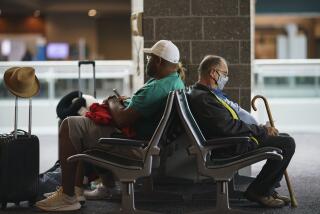Ways to Know Whether You’re Coming or Going
- Share via
Fourteen hours of near-continuous sitting. Two meals, three snacks. Four beverage services. Two movies. Two duty-free shopping opportunities. Two airline magazines. Eight channels of radio. Six progress reports from the captain.
Long-range jets fly you nonstop to the other side of the globe with many of the comforts of home. But the human body was made for moving about--on the ground.
Even asleep, you change position several times an hour. Prolonged sitting is fatiguing and causes aches and pains in muscles and joints.
So here are some tips to minimize discomforts and help you arrive at your destination raring to go:
--Keep busy. Boredom makes time drag and draws attention to discomforts. Watch the movies. Do paper work. Read. Talk to your neighbors.
--Proper sitting helps prevent aches and pains, sore backs and swollen feet. Keep your seat upright, put a pillow in the small of your back and fasten the seat belt tightly around your hips.
Keep the back of your thighs off the seat by slightly elevating your feet. If necessary, rest your feet on a briefcase, bag or blanket. Using a blanket helps reduce vibrations from the aircraft.
Do not cross your legs and do not keep the backs of your legs tightly against the front of the seat. Both positions interfere with blood circulation, and crossing your legs also shifts body weight to your lower back and contributes to pain there.
Every hour, spend a few minutes walking in place, and a minute or two flexing and extending your toes.
Ideally, sleep in the preferred sitting position. Carry an inflatable pillow that fits around your neck to support your head. Such pillows are available at many airport shops.
--Carry a sweater. Airplane cabins are often uncomfortably cool. Ask flight attendants to raise the temperature if need be.
--Wear shoes with laces. Such shoes are easier to put back on if your feet swell. Flight attendants have shoehorns.
Avoid tight undergarments and stockings--they may interfere with circulation to the feet. But conversely, if you have a history of varicose veins or circulation problems, consider wearing elastic support hose.
--Eat small portions of food starting two hours before takeoff, and avoid gas-producing and greasy foods.
--Avoid large meals for several hours after landing, to “shrink” your stomach to its normal size.
--Chew gum only to relieve ear discomfort. Chew slowly.
--Minimize alcoholic beverages before and during flights.
--If possible, avoid eating and drinking at hours when your stomach is ordinarily at rest--3 a.m., for example.
--Eat food high in fiber.
--Drink one pint of fluid for every three flying hours. The lack of fluids (dehydration) aggravates fatigue and jet lag, may contribute to blot clots and causes dryness of eyes, skin, mouth and throat. Use eyedrops and skin moisturizers, if uncomfortable. The best fluids are water or fruit juices.
--Long flights cause unusual, sometimes bizarre reactions to medication. Take only medications that are essential.
Some flights may take you through eight or more time zones. If you take daily medication, know in advance whether you will need an extra half-dose at your destination.
--Stop smoking several hours before flights and sit away from the smoking area. Smoking worsens jet lag and fatigue, reacts with medications and may increase chances of forming blood clots in your legs.
--Limit yourself to short naps on day flights. Try to sleep during night flights; this minimizes jet lag. Sleeping aids include music, eyeshades, earplugs, keeping warm and sitting away from busy and noisy areas of the aircraft.
More to Read
Sign up for The Wild
We’ll help you find the best places to hike, bike and run, as well as the perfect silent spots for meditation and yoga.
You may occasionally receive promotional content from the Los Angeles Times.






